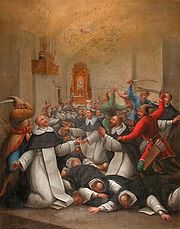Second Mongol invasion of Poland
This article includes a list of general references, but it lacks sufficient corresponding inline citations. (August 2013) |
| Second Mongol invasion of Poland | |||||||
|---|---|---|---|---|---|---|---|
| Part of the Mongol invasion of Europe | |||||||
 Martyrdom of Sadok and 48 Dominican martyrs of Sandomierz during the Second Mongol invasion of Poland. | |||||||
| |||||||
| Belligerents | |||||||
|
|
| ||||||
| Commanders and leaders | |||||||
|
Bolesław V the Chaste various others | |||||||
| Strength | |||||||
| 20,000[1]–30,000[2] |
9,000[3]
| ||||||
| Casualties and losses | |||||||
| Light | Heavy | ||||||
The second Mongol invasion of Poland was carried out by General Boroldai (Burundai) of the Golden Horde in 1259–1260. During this invasion the cities of Sandomierz, Kraków, Lublin, Zawichost, and Bytom were sacked by the Mongols for the second time.[4][5]
History
The invasion began in late 1259, after a powerful Mongol army had been sent to the
The purpose of the invasion was to loot the divided
The events that took place in the Kingdom of Galicia–Volhynia echoed in Lesser Poland, and in late 1258, preparations for the defence of Kraków began. The work was quickly abandoned, and
The Mongolian army concentrated near Chełm, and after capturing Polish towns east of the Vistula, the invaders appeared at Sandomierz (early December 1259). Boroldai ordered Ruthenian auxiliary units to besiege and capture the city, while main Mongol forces marched westwards toward the Holy Cross Mountains. Their march was marked by an orgy of destruction; among others, ancient abbeys of Koprzywnica and Wąchock were looted (most probably, they failed to capture the Łysa Góra Benedictine Abbey). The Mongols limited their advance to Radom in the north and Sulejów in the west, and did not enter other Polish provinces. The two columns of the invading army joined forces near Kielce and Chęciny, in mid-January 1260.
At the same time, the siege of Sandomierz continued. Defenders of the city fiercely resisted all attacks of the Mongol and Ruthenian forces. After several weeks, Mongol leaders began negotiations with the Poles, who were commanded by a man named Piotr of Krepa. Ruthenian princes, which took part in the siege, advised Piotr of Krepa to accept Mongol offers, and abandon Sandomierz, in exchange of safe passage for all residents of the city. Finally, facing hunger and epidemics, the Poles left Sandomierz on February 2, 1260; the Mongols broke their promise and massacred the civilians and the defenders. The city itself was looted and burned to the ground.
On February 5, main Mongol forces abandoned Sandomierz. All units joined forces on February 10–12, and entered densely populated southern Lesser Poland. After looting the abbeys at
In late March 1260, the Mongols left Lesser Poland eastward along the
Aftermath
Lesser Poland was devastated by the invasion, with the Mongols acquiring much rich loot from their expedition. Some 10,000 Poles were taken with the Mongol invaders as slaves. Through this invasion, the Golden Horde successfully managed to destroy Bolesław’s anti-Mongol alliance and fully subjugate the Kingdom of Galicia–Volhynia.
References
- ISBN 9781635687125.
- S2CID 203312568.
- ^ Stanisław Krakowski, Polska w walce z najazdami tatarskimi w XIII wieku, MON, 1956, pp. 181-201
- ISBN 978-83-01-00392-0.
- ISBN 978-90-04-18010-9.



